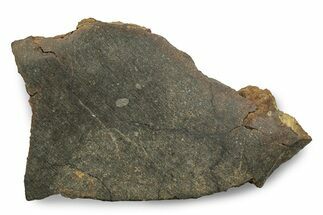This Specimen has been sold.
1.89" Polished Chondrite Meteorite (6.6 g) Slice - NWA 7040
This is a 1.89" wide (6.60 gram) slice of the chondrite meteorite, NWA 7040. It has been lightly polished on one side to highlight the small round chondrules and angular fragments.
Comes with a riker mount display case.
Comes with a riker mount display case.
About Meteorite NWA 7040
NWA 7040 is a small find from 2011 in Northwest Africa, with a total mass of 1740 grams. It's an H3.4 chondrite with small, well-developed round chondrules and some angular mineral fragments. Its matrix is rich in ferroan olivine with pyrrhotite and altered kamacite. Additional minerals present include olivine, orthopyroxene, subcalcic augite, sodic plagioclase, chromite, and troilite.
Meteoritical Bulletin: Entry for Chondrite Meteorite NWA 7040
NWA 7040 is a small find from 2011 in Northwest Africa, with a total mass of 1740 grams. It's an H3.4 chondrite with small, well-developed round chondrules and some angular mineral fragments. Its matrix is rich in ferroan olivine with pyrrhotite and altered kamacite. Additional minerals present include olivine, orthopyroxene, subcalcic augite, sodic plagioclase, chromite, and troilite.
Meteoritical Bulletin: Entry for Chondrite Meteorite NWA 7040
About Chondrites
Chondrites are stony (non-metallic) meteorites that have not been modified by either melting or differentiation of the parent body. They are formed when various types of dust and small grains in the early Solar System accreted to form primitive asteroids. Some such bodies are captured in the planet’s gravity well and pulled to the surface. They are by far the most common type of meteorite, representing about 86 percent of all meteorites that have fallen to Earth.
Prominent among the components present in chondrites are the enigmatic chondrules, millimeter-sized spherical objects that originated as freely floating, molten or partially molten droplets in space; most chondrules are rich in the silicate minerals olivine and pyroxene. Chondrites also contain particles of various metals such as nickel, iron, and aluminum. These formed at the very beginning of the solar system and aggregated over time: they are the oldest rocks known on Earth!
Chondrites are divided into about fifteen distinct groups on the basis of their mineralogy, bulk chemical composition, and oxygen isotope compositions. The various chondrite groups likely originated on separate asteroids or groups of related asteroids. Each chondrite group has a distinctive mixture of chondrules, refractory inclusions, matrix (dust), characteristic chondrule sizes, and other components. Other ways of classifying chondrites include weathering and shock. The L chondrite group is the most common of these.
Chondrites are stony (non-metallic) meteorites that have not been modified by either melting or differentiation of the parent body. They are formed when various types of dust and small grains in the early Solar System accreted to form primitive asteroids. Some such bodies are captured in the planet’s gravity well and pulled to the surface. They are by far the most common type of meteorite, representing about 86 percent of all meteorites that have fallen to Earth.
Prominent among the components present in chondrites are the enigmatic chondrules, millimeter-sized spherical objects that originated as freely floating, molten or partially molten droplets in space; most chondrules are rich in the silicate minerals olivine and pyroxene. Chondrites also contain particles of various metals such as nickel, iron, and aluminum. These formed at the very beginning of the solar system and aggregated over time: they are the oldest rocks known on Earth!
Chondrites are divided into about fifteen distinct groups on the basis of their mineralogy, bulk chemical composition, and oxygen isotope compositions. The various chondrite groups likely originated on separate asteroids or groups of related asteroids. Each chondrite group has a distinctive mixture of chondrules, refractory inclusions, matrix (dust), characteristic chondrule sizes, and other components. Other ways of classifying chondrites include weathering and shock. The L chondrite group is the most common of these.
TYPE
Ordinary Chondrite (H3.4)
AGE
LOCATION
Northwestern Africa
SIZE
1.89 x .97", .10" thick, 6.60 grams
CATEGORY
SUB CATEGORY
ITEM
#304407
 Reviews
Reviews













